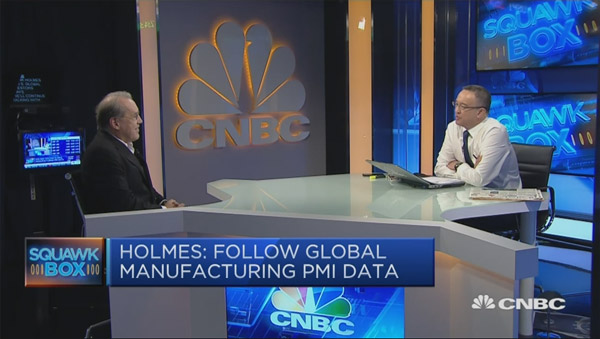by Frank Holmes, CIO, CEO, U.S. Global Investors

Nearly 10 years after the financial crisis brought the global economy to its knees, conditions have finally improved enough to crystallize my conviction that synchronized global growth is currently underway. Revenue and earnings growth are up year-over-year, not just in the U.S. but worldwide. Despite President Donald Trump threatening to raise tariffs and tear up trade deals, global trade is accelerating. World manufacturing activity expanded to a 78-month high of 53.5 in October, with faster rates recorded in new orders, exports, employment and input prices.
Additional trends and indicators support my bullishness. Worldwide business optimism, as recorded by October’s IHS Markit Global Business Outlook survey, climbed to its highest level in three years, with profits growth and hiring plans continuing to hit multiyear highs. Optimism among U.S. firms was at its highest since 2014, with sentiment above the global average for the second straight survey period.
Small business owners’ optimism remained at historically high levels in October, according to the latest survey conducted by the National Federation of Independent Business (NFIB). Its Small Business Optimism Index came in at 103.8, up slightly from September and extending the trend we’ve seen since the November 2016 election.
As I told CNBC Asia anchor Bernie Lo last week, U.S., Europe and China’s economies are strong, which is igniting the rest of the world. The eurozone purchasing manager’s index (PMI), in particular—rising to 58.5 in October, an 80-month high—is very constructive for world economic growth in the next six months.

Fewest Number of Countries in Recession
Speaking on CNBC’s “Trading Nation” recently, Deutsche Bank chief international economist Torsten Slok made the case that global economic health “has never been more robust,” citing the fact that the number of countries in recession has dropped to its lowest level in decades.
“We have never seen a smaller number of countries in recession as we do at the moment,” Slok said. “And if you look ahead to the next few years… we are going to see that fall even lower.”
The Organization for Economic Cooperation and Development (OECD) backs up this claim in its quarterly economic outlook. According to the Paris-based group, synchronized global growth is finally within sight, with no major economy in contraction mode for the first time since 2008. World GDP is expected to advance 3.5 percent in 2017—its best year since 2011—and 3.7 percent in 2018.
Taken together, this should help boost exports and global trade even further as more countries have the capital and demand to make purchases on the world market.
Exposure to Foreign Markets Boosted Companies’ Bottom Line
Bolstered by a weaker U.S. dollar, exports by American firms hit a three-year high in August, the Commerce Department reported this month. Exports rose to nearly $200 billion, the highest level since December 2014.
As further proof that the global economy is humming along, S&P 500 Index companies with greater exposure to foreign markets, especially Europe, saw higher revenue and earnings growth in the third quarter than those companies whose business is more focused domestically.
According to FacSet data, revenue grew 10 percent year-over-year for firms that generated 50 percent or more of their sales outside the U.S., compared to only 4.2 percent for firms whose sales were conducted mostly within the U.S. The difference was even greater for earnings growth—13.4 percent for S&P 500 companies with strong foreign exposure, 2.3 percent for companies with less exposure.
We saw similarly impressive results with Dow Jones Industrial Average (DJIA) companies. According to FactSet’s November 17 Earnings Insight :
Overall, 11 of the 30 companies in the DJIA provided revenue growth numbers for Europe for the third quarter. Of these 11 companies, nine reported year-over-year growth in revenues. This number was the highest number of Dow 30 companies… to report revenue growth in Europe on a quarter basis since Q2 2014. Of these nine companies, five reported double-digit revenue growth in Europe for the third quarter.
FactSet adds that Nike reported its seventh straight quarter of year-over-year revenue growth in European markets, Apple its fifth straight quarter.
As of Friday, 95 percent of S&P 500 companies have reported earnings for the third quarter, and of those, nearly three quarters have logged earnings per share (EPS) that are above the five-year average.
The U.S. isn’t the only economy that’s had a standout quarter. According to Thomson Reuters data, 65 percent of companies in the MSCI Europe Index have beaten third-quarter expectations, with overall year-over-year earnings growth standing at nearly 10 percent.
Enthusiasm Over Corporate Tax Cuts Drive Stock Prices Higher
As you’re likely aware, it’s been one year since the U.S. election, and since then the market has surged more than 21 percent on improved global growth, higher corporate earnings and hopes that President Trump’s pro-growth agenda of tax reform and deregulation will improve business conditions in the U.S. In the past 12 months, there have been nearly three times as many weeks posting market gains above 1 percent than those with losses below negative 1 percent. This makes it one of the most profitable markets to have invested in for many years.
So where does the Trump rally rank? Looking at the 12 months following every November presidential election since 1950, LPL Research found that the bull run we’ve seen under Trump ranks fifth place, following Presidents Bush Sr. in 1988; Obama in 2012; Kennedy in 1960 and, in first place, Clinton in 1996, with gains climbing to nearly 32 percent.
|
Where Does the Trump Rally Rank? |
||||
| Election Date | Winning President | S&P 500 Return One Year Later | Rank | |
| 11/05/1996 | Clinton | 31.7% | 1 | |
| 11/08/1960 | Kennedy | 28.4% | 2 | |
| 11/06/1912 | Obama | 23.9% | 3 | |
| 11/08/1988 | Bush Sr. | 21.7% | 4 | |
| 11/08/2016 | Trump | 21.1% | 5 | |
| Past performance does not guarantee future results. Source: LPL Research, FactSet, U.S. Global Investors |
||||
Before year’s end, we could see prices appreciate even more as investors act on enthusiasm over tax reform. Last week the House approved $1.5 trillion in tax cuts that, if signed into law, would slash corporate taxes down from 35 percent to a much more competitive 20 percent. The bill is now in the Senate’s court where hopefully it doesn’t suffer the same fate as the failed Obamacare repeal-and-replace efforts. Goldman Sachs analysts place the chances of tax reform being completed by early 2018 at 80 percent—encouraging for sure, but there are some tough challenges ahead. A handful of Republican Senators, including Jeff Flake (AZ) and Ron Johnson (WI), have already said they will not vote for the Senate bill as it’s currently written.
Despite the bill’s uncertain future, markets responded very favorably to the House news. The S&P 500 Index closed up 0.82 percent on Thursday, its best one-day move since June, with gains led by retailers such as Foot Locker, Ross Stores and Gap.
This week I’ll have more to add on consumer spending forecasts for the upcoming holiday shopping season. This Black Friday is expected to be the largest-ever for online shopping. In the meantime, explore investment opportunities in domestic companies with exposure to foreign markets by clicking here!
The Purchasing Managers' Index (PMI) is an indicator of the economic health of the manufacturing sector. The PMI is based on five major indicators: new orders, inventory levels, production, supplier deliveries and the employment environment.
The Business Outlook Survey for Global Manufacturing and Services is based on a survey of around 11,000 manufacturers and service providers that are asked to give their thoughts on future business conditions. The reports are produced on a tri-annual basis, with data collected in February, June and October.
The Small Business Optimism Index is compiled from a survey that is conducted each month by the National Federation of Independent Business (NFIB) of its members.
The Standard & Poor's 500, often abbreviated as the S&P 500, or just the S&P, is an American stock market index based on the market capitalizations of 500 large companies having common stock listed on the NYSE or NASDAQ. The S&P 500 index components and their weightings are determined by S&P Dow Jones Indices.
The Dow Jones Industrial Average (DJIA) is a price-weighted average of 30 significant stocks traded on the New York Stock Exchange (NYSE) and the NASDAQ. The DJIA was invented by Charles Dow back in 1896.
The MSCI Europe Index captures large and mid-cap representation across 15 Developed Markets (DM) countries in Europe. With 445 constituents, the index covers approximately 85% of the free float-adjusted market capitalization across the European Developed Markets equity universe.
Holdings may change daily. Holdings are reported as of the most recent quarter-end. The following securities mentioned in the articles were held by one or more accounts managed by U.S. Global Investors as of 9/30/2017: NIKE Inc. 2.87%, Foot Locker Inc. 1.99%.
All opinions expressed and data provided are subject to change without notice. Some of these opinions may not be appropriate to every investor. By clicking the link(s) above, you will be directed to a third-party website(s). U.S. Global Investors does not endorse all information supplied by this/these website(s) and is not responsible for its/their content.
This post was originally published at Frank Talk.
Copyright © U.S. Global Investors


















